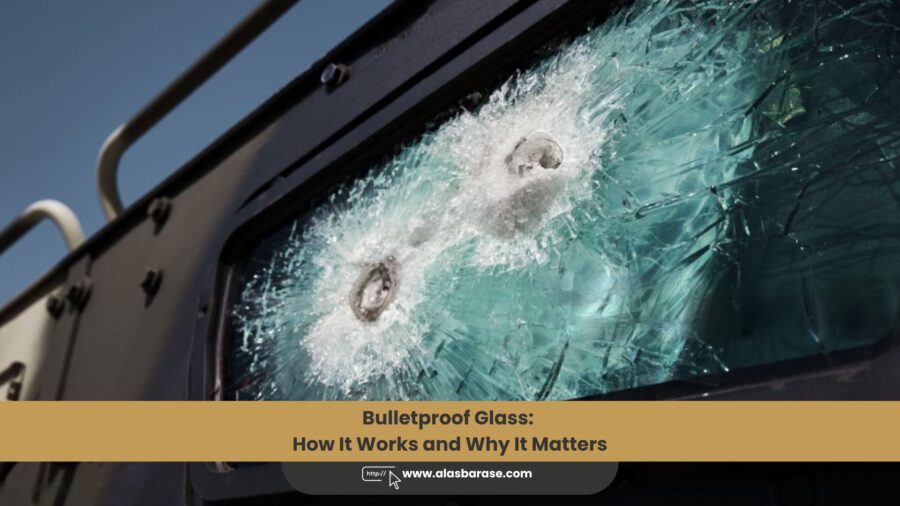In an ever-changing world where security concerns are paramount, bulletproof glass stands as a testament to human ingenuity and the relentless pursuit of safety. This remarkable material, also known as ballistic glass or transparent armor, has become an indispensable component in various sectors, from automotive to architecture. But what exactly is bulletproof glass, and how does it work?
Bulletproof glass is a specially engineered composite material designed to resist penetration by projectiles, particularly bullets. Unlike regular glass, which shatters upon impact, bulletproof glass absorbs and dissipates the energy of a bullet, preventing it from passing through. This seemingly magical property is the result of careful engineering and advanced materials science.
As we delve deeper into the world of bulletproof glass, we’ll explore its composition, manufacturing process, and the wide range of applications that make it a crucial element in modern security systems. From protecting world leaders to safeguarding everyday citizens, bulletproof glass plays a vital role in our lives, often without us even realizing it.
In this comprehensive guide, we’ll uncover the secrets behind bulletproof glass, examine its various types and levels of protection, and look at the innovative technologies shaping its future. Whether you’re a security professional, a curious enthusiast, or someone looking to enhance their safety measures, this article will provide you with valuable insights into the fascinating world of bulletproof glass.
Key Takeaways:
- Bulletproof glass is a composite material designed to resist bullet penetration
- It’s made by layering glass with polycarbonate or other materials
- Applications range from automotive to architecture and personal protection
- Different types and levels of bulletproof glass exist for various threat levels
- Ongoing innovations are improving the strength and versatility of bulletproof glass
The Science and Manufacturing of Bulletproof Glass
Bulletproof glass is not a single material but a carefully engineered composite. At its core, it consists of multiple layers of glass and plastic bonded together to create a material that is both strong and flexible. The most common types of bulletproof glass include laminated glass, glass-clad polycarbonate, acrylic, and all-polycarbonate variants. Each type has its unique properties and applications, but they all share the common goal of stopping bullets and other high-velocity projectiles.
The key to bulletproof glass’s effectiveness lies in its layered structure. When a bullet strikes the glass, the layers work together to absorb and disperse the energy:
- The outer layer of glass shatters, absorbing some of the initial impact.
- The plastic interlayers stretch and deform, further dissipating energy.
- Additional glass layers may crack but remain held together by the plastic.
- The inner layer, often polycarbonate, provides a final barrier to prevent penetration.
This complex interaction of materials allows bulletproof glass to stop bullets while maintaining its structural integrity. The physics behind this process involves principles of energy absorption, deformation, crack propagation control, and spall prevention.
The manufacturing process of bulletproof glass is equally fascinating and complex. It begins with the careful selection of high-quality raw materials, including glass sheets (typically tempered or heat-strengthened), polycarbonate, and interlayer materials such as polyvinyl butyral (PVB) or ethylene-vinyl acetate (EVA). These materials are precisely cut and shaped to the required specifications.
The assembly process involves stacking alternating layers of glass and polycarbonate, with interlayer materials placed between each layer. This stack is then placed in an autoclave, where heat and pressure are applied to fuse the layers together. This bonding process is crucial, as it ensures that the layers work together as a single unit to resist bullet penetration.
After manufacturing, each piece of bulletproof glass undergoes rigorous quality control and testing. This includes visual inspection for imperfections, transparency testing to ensure optical clarity, and ballistic testing where samples are subjected to actual bullet impacts to verify protection levels.
“The aim is to make a material with the appearance and clarity of standard glass but with effective protection from small arms.”
Highlighted Key Points:
- Bulletproof glass is a composite of glass and plastic layers
- Energy absorption and controlled deformation are key to its effectiveness
- The manufacturing process involves precise layering and autoclave bonding
- Rigorous testing ensures the glass meets required protection standards
Applications and Types of Bulletproof Glass
Bulletproof glass finds applications across a wide range of industries and sectors, each with its unique requirements and challenges. In the automotive industry, it’s used in armored vehicles for high-profile individuals, government officials, and military personnel. Even standard vehicles often use laminated safety glass in windshields to prevent shattering during accidents. Public transportation in high-risk areas may also incorporate bulletproof glass for passenger safety.
Government agencies and military organizations are major users of bulletproof glass. Embassy buildings, military vehicles, and secure government facilities all rely on this technology to protect personnel and sensitive information. Financial institutions, such as banks, use bulletproof glass in teller windows, ATM enclosures, and vault areas to prevent robberies and protect assets.
In the retail and commercial sector, businesses like jewelry stores, convenience stores, and pharmacies often implement bulletproof barriers to protect high-value merchandise and employees, especially in high-crime areas. Even residential applications are growing, with wealthy individuals or those in high-risk professions installing bulletproof windows and doors in their homes or creating secure “safe rooms.”
Bulletproof glass is classified into different levels based on its ability to withstand various types of ammunition. The most common standards are the Underwriters Laboratories (UL) 752, which defines eight levels of protection, and the National Institute of Justice (NIJ) Standard. In Europe, the EN 1063 standard is used. Understanding these levels is crucial for selecting the appropriate type of bulletproof glass for specific security needs.
Several types of bulletproof glass are available, each with its own strengths and applications:
- Acrylic: Lightweight and cost-effective, suitable for lower threat levels.
- Polycarbonate: Extremely strong and lightweight, often used in high-security applications.
- Glass-Clad Polycarbonate: Combines the strength of polycarbonate with the scratch resistance of glass.
- Laminated Glass: Multiple layers of glass bonded with PVB, offering good protection and optical clarity.
Choosing the right type and level of bulletproof glass depends on several factors, including threat assessment, environmental conditions, weight constraints, optical requirements, and budget considerations.
“Bullet-resistant glass is used in windows of buildings that require such security, such as jewelry stores and embassies, and of military and private vehicles.”
Highlighted Key Points:
- Bulletproof glass is crucial in automotive, government, and financial sectors
- Different types of bulletproof glass offer varying levels of protection
- Choosing the right protection involves assessing threats and environmental factors
Innovations and Future Trends in Bulletproof Glass
The field of bulletproof glass is continuously evolving, with researchers and engineers pushing the boundaries of what’s possible. Advancements in materials science are leading to the development of even stronger and lighter bulletproof glass. Nano-materials like carbon nanotubes and graphene are being integrated to enhance strength without adding weight. Self-healing polymers that can repair minor damage automatically are also being developed, as well as transparent aluminum (aluminum oxynitride or ALON) that offers exceptional strength and clarity.
Smart glass technologies are being integrated with bulletproof glass, opening up new possibilities. Electrochromic glass that can switch from transparent to opaque for added privacy, embedded sensors that can alert security systems upon impact, and heads-up displays for information overlay are just a few examples of how bulletproof glass is becoming more than just a protective barrier.
Environmental considerations are also driving innovation in the bulletproof glass industry. There’s a growing focus on developing more easily recyclable composites, improving the thermal insulation properties of bulletproof glass to reduce building energy consumption, and implementing eco-friendly manufacturing processes.
The applications of bulletproof glass are expanding beyond traditional security roles. In space exploration, it’s being used to protect spacecraft and habitats from micrometeorites. Extreme sports are utilizing bulletproof glass to enhance safety in high-risk activities. Even wildlife conservation efforts are benefiting from bulletproof glass, protecting researchers and tourists in dangerous environments.
“The properties of bullet-resistant glass can be affected by temperature and by exposure to solvents or UV radiation, usually from sunlight.”
Highlighted Key Points:
- Nano-materials and smart technologies are shaping the future of bulletproof glass
- Environmental considerations are driving innovations in materials and production
- New applications are expanding the use of bulletproof glass beyond security
What Al Asbar ASE Auto Development LLC Can Offer
Al Asbar ASE Auto Development LLC is at the forefront of bulletproof glass technology, offering cutting-edge solutions for automotive and architectural applications. Our expertise includes custom bulletproof glass tailored for specific vehicle models and building designs, advanced installation services for both vehicles and structures, and expert consultation to help clients choose the right level of protection for their unique needs.
We pride ourselves on our ongoing maintenance and repair services, ensuring the longevity and effectiveness of bulletproof glass installations. Our commitment to research and development keeps us ahead of emerging threats and technologies, allowing us to offer the most advanced protection solutions to our clients.
With Al Asbar ASE Auto Development LLC, clients aren’t just getting bulletproof glass; they’re investing in peace of mind and state-of-the-art protection. Our comprehensive approach to security, combined with our deep understanding of bulletproof glass technology, makes us a trusted partner for individuals, businesses, and government agencies seeking the highest level of protection.
Frequently Asked Questions
Bulletproof glass, also known as ballistic glass or transparent armor, is a specially engineered composite material designed to resist penetration by bullets and other high-velocity projectiles. It’s typically made by layering multiple sheets of glass with interlayers of polycarbonate or other plastic materials. This combination allows the glass to absorb and dissipate the energy of a bullet impact, preventing it from passing through. While no glass is truly “bulletproof,” this material significantly increases protection against ballistic threats.
Bulletproof glass works by utilizing a layered structure to absorb and disperse the energy of a bullet impact. When a bullet strikes the glass, several processes occur simultaneously:
- The outer layer of glass shatters, absorbing some of the initial impact energy.
- The plastic interlayers stretch and deform, further dissipating energy.
- Subsequent glass layers may crack but remain held together by the plastic.
- The inner layer, often polycarbonate, provides a final barrier to prevent penetration.
This multi-layered approach allows the glass to stop bullets while maintaining its overall structural integrity, preventing shards from harming those behind the glass.
There are several types of bulletproof glass, each with its own characteristics:
- Laminated Glass: Multiple layers of glass bonded with polyvinyl butyral (PVB) or ethylene-vinyl acetate (EVA).
- Glass-Clad Polycarbonate: A combination of glass layers and polycarbonate, offering superior protection.
- Acrylic: A lightweight option suitable for lower threat levels.
- All-Polycarbonate: Extremely strong and lightweight, often used in military applications.
The choice of type depends on the specific security requirements and environmental conditions.
The thickness of bulletproof glass varies depending on the level of protection required. For basic handgun protection, bulletproof glass can be as thin as 3/4 inch (19mm). For higher threat levels, such as protection against high-powered rifles, the thickness can increase to 3 inches (76mm) or more. The exact thickness depends on the materials used, the layering technique, and the specific ballistic rating required.
No, bulletproof glass is not universally effective against all types of bullets. The level of protection offered depends on the specific design and rating of the glass. Bulletproof glass is typically rated according to standards set by organizations like Underwriters Laboratories (UL) or the National Institute of Justice (NIJ). These ratings specify which types and calibers of ammunition the glass can withstand. While some high-grade bulletproof glass can stop rounds from high-powered rifles, there’s always a limit to what it can withstand.
The lifespan of bulletproof glass depends on various factors, including the type of glass, environmental conditions, and maintenance. In general, high-quality bulletproof glass can last 20 years or more under normal conditions. However, exposure to extreme temperatures, UV radiation, or certain chemicals can degrade the glass over time. Regular inspections and maintenance can help extend the life of bulletproof glass. It’s important to note that even if bulletproof glass hasn’t been struck by a bullet, it may need replacement after a certain period to ensure optimal protection.
While bulletproof glass is extremely strong, it’s not indestructible. Given enough force or the right tools, it can be broken. However, the purpose of bulletproof glass is not to be unbreakable, but to resist penetration long enough to protect the people behind it. Even when damaged by bullets, bulletproof glass is designed to maintain its overall structure and continue providing protection. It’s worth noting that repeated impacts in the same area can eventually compromise the glass’s integrity.
In most countries, including the United States, bulletproof glass is legal for civilian use. There are generally no restrictions on purchasing or installing bulletproof glass in homes or vehicles. However, some countries may have regulations regarding the export or import of bulletproof materials. It’s always best to check local laws and regulations before purchasing or installing bulletproof glass.
The cost of bulletproof glass varies widely depending on factors such as the level of protection, size, and application. For automotive use, a basic bulletproof windshield might cost between $3,000 to $5,000, while a full set of bulletproof glass for a luxury vehicle could exceed $20,000. For buildings, the cost is typically calculated per square foot and can range from $25 to $100 or more, depending on the level of protection. Custom solutions or high-end applications can be significantly more expensive.
Yes, bulletproof glass can be used in residential homes. While it’s less common than in commercial or government applications, some homeowners choose to install bulletproof glass for enhanced security. This is particularly true for high-profile individuals or those living in high-crime areas. Bulletproof glass can be installed in windows, doors, or used to create safe rooms within a home. However, the high cost and specialized installation requirements mean it’s not a common feature in most residential properties.





